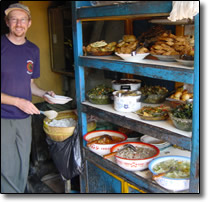
Yogyakarta
Long a popular tourist destination, Yogyakarta is a large, bustling city. Unlike Solo, it was impossible here to go anywhere without being accosted by rickshaw drivers and seedy batik salesmen. Jalan Marlioboro, the main thoroughfare, is lined with street vendors and shops catering to local as well as foreign tourists. After finding ourselves a cheap hotel in the tourist ghetto, we set out to see some of the sights. There is some interesting colonial architecture around the city, and the “kraton”, or sultan’s palace, is impressive. Surrounding the kraton is a whole quarter of small houses and narrow streets. In a small alley near our hotel we found a great place to eat. For 3000 Rp (about 30 cents) we could eat a big bowl of rice accompanied with various dishes of vegetables, fried tempe and tofu. Meat, charged by the piece, cost a little bit more. The place was popular and the food was delicious, ensuring a rapid turnover. As long as our favorite, fried sweet-and-sour tempe, was still left, we were happy to pile our plates high and dig in, with a glass of homemade sweet lemonade to wash it down. That night we attended a “wayang kulit” (leather shadow puppet) show. At the entrance we started chatting with the ticket sellers and pretty soon one of them, the “manager”, wanted to accompany us inside to explain the story and talk about the puppets. He didn’t seem to have any other important work to do, so we plied him with questions about the show, the technique, the music, everything. The so-called “manager” stuck around, not really interested in the other guests or in selling tickets, but was friendly enough, and didn’t seem to be selling anything, so we didn’t mind. We sat behind the screen so we could watch the gamelan players along with the puppet-master as he single-handedly conducted the orchestra, animated the puppets, talked, sang and provided sound effects by tapping a small metal gong with a stylus held between his toes. On his right and left, arranged in increasing size, were hundreds of flat leather puppets stuck into the trunk of a banana trunk. The master would take a puppet, move it onto the stage, make it talk and gesticulate, and then, with a satisfying “thunk” timed with a ring of the gong, would stick it fast into place, where it would remain in view while the story continued.
 |
 |
A large, Christmas-tree shaped figure was used to cue scene changes. Though we knew the story, an episode of the Ramayana, it was impossible to follow the spoken Javanese. While the master could make the puppets fight like kung-fu artists, fly and shoot arrows, everything was accompanied with drawn-out song and dialogue. Meanwhile, our manager friend returned to see if we were enjoying the performance. He began to praise the puppets and their workmanship, but admitted that these puppets were not “first quality”. Would we be interested in seeing something better? We weren’t really, but we had nothing special planned after the show, so why not? Our manager friend, who now seemed a sideline puppet pusher, drove us to his house, where he showed us some of his work. He described people who had bought his top-quality work to display in museums. We had to admit that his puppets were beautiful, but isn’t 60 Euro a little steep? Even for “first quality”? He countered with a comment on hotel prices, and then asked us diplomatically where we were staying. Telling him the name of our hotel sealed our fate. (We were paying $2.50 a night for our room.) We proposed to return “tomorrow” to see his workers in action. He accepted to drive us back to our neighborhood, saying, very politely, without losing face, “If you are staying in Losmen Anda [our hotel], you will have plenty of money left over to buy puppets!”
The next day we took a side trip to Dieng plateau, a large volcanic cauldron at 1200m. The whole area was under intense agriculture. The hillsides, smelling strongly of fertilizer, were terraced with vegetable and potato plantations. The restored temples are small and the “natural wonders” are full of trash. Disappointed, we returned to Yogyakarta.
 |
 |
Back in Yogyakarta, we met another Indonesian-speaker, Marc, staying at our hotel. Marc had spent a lot of time in Indonesia and knew the language well. Together we could swap stories and talk about typical words and expressions. Marc told us about his first experience in Indonesia, living with a family of Bugis peasants in South Sulawesi. When he arrived, Marc talked about his family in Canada, admitting that his own father had recently passed away. His host father promptly marched him to the town hall and formally adopted him! The Bugis have a tradition that when a boy’s father dies, another man in the village is required to adopt him, and treat him as a son. Marc’s new father then took him around the markets in the area, and, introducing him to the vendors, instructed them not to overcharge his new son. From here on, though, Marc was obliged to return “home” every year to work “his” rice fields in order to help feed “his” sisters. Did he have to bring money to his father whenever he returned? Yes, said Marc, but he always arranged not to bring more than his older brother, who lived in Jakarta.
